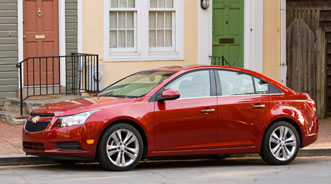Chevy: Buying Trends Show Shift to Four-Cylinder Engines

The days of Chevrolet’s retail sales being significantly dependent upon models with large engines appears to be waning. Brand officials revealed Wednesday that models with smaller, four-cylinder engines have accounted for 46 percent of their retail sales thus far this year, making this feature the top choice in the Chevrolet lineup
To illustrate the change, Chevrolet mentioned that back in 2007 four-cylinder models represented 23 percent of its retail sales in the United States, less than either V-6 or V-8 equipped models.
However, the company is now finding customers are moving out of V-8 powered SUVs into V-6 powered crossovers like the Traverse, and from V-6 powered cars and crossovers into fuel-efficient four-cylinder models, such as Cruze, Malibu and Equinox.
“Chevrolet’s investment in advanced engine technology is reflected in the increased popularity of our four-cylinder models,” explained Rick Scheidt, U.S. vice president for Chevrolet.
“These technologies offer the performance and refinement drivers expect from Chevy in smaller engines that deliver the fuel efficiency they want,” Scheidt added.
Given this shift in consumer tastes, the automaker boasted about its four-cylinder technology. The brand detailed three more examples of how Chevy is applying technology to improve the performance, refinement and fuel efficiency of its four-cylinder line:
—Turbocharging helps Chevrolet Cruze Eco deliver 42 mpg highway: The Cruze is available with turbocharged, Ecotec 1.4L four-cylinder engine that combines the fuel efficiency of a small engine with the power of a much larger engine when needed.
“The turbocharged engine delivers 138 horsepower and 148 pound feet of torque and up to 42 miles per gallon on the highway for Cruze Eco models — more than any other gasoline-powered car in the United States,” brand officials highlighted.
By comparison, the 2009 Chevrolet Cobalt XFE featured a larger 2.2 liter four-cylinder with nearly identical output at 148 horsepower and 152 lb-ft of torque, but five fewer miles per gallon on the highway.
The brand pointed out the 1.4L, turbocharged engine will also be used in the all-new Chevrolet Sonic, which will arrive at U.S. dealers this fall.
—Variable Valve Timing helps Chevrolet Malibu deliver 33 mpg highway: The Malibu features an Ecotec 2.4L four-cylinder engine, with variable valve timing that precisely adjusts the opening and closing of the engine valves to meet demand.
Chevy said the result improves performance and fuel economy for the Malibu, with 170 horsepower, 160 lb-ft of torque, and an EPA estimated 33 miles per gallon on the highway.
The brand added variable valve timing is featured on 12 Chevrolets, including the Camaro, Volt, Cruze and Silverado.
—Direct injection helps Chevrolet Equinox reach 32 mpg highway: The Equinox also features an Ecotec 2.4L engine, with both variable valve timing and direct injection.
“Compared to traditional fuel-injection, direction injection sprays fuel directly into the cylinder — enabling more precise fuel delivery for improved performance, fuel efficiency and reduced emissions,” brand officials emphasized.
In the Equinox, the direct-injection 2.4L Ecotec is rated at 182 horsepower, and 172 lb.-ft. of torque, while delivering an EPA-estimated 32 mpg highway. Chevrolet believes that’s more than any vehicle in its class, including the Ford Escape Hybrid.
By comparison, the brand noted the previous-generation 2008 Equinox had a 3.4L V-6 that delivered a comparable 185 horsepower and 210 lb.-ft. of torque with 24 mpg highway.
Direct injection is also available on the Camaro V-6, the Equinox V-6 and the Traverse crossover.
“The shift in consumer preference evidenced by Chevrolet’s lineup is a great example of how much four-cylinder engines have improved across the industry,” stated Bill Visnic, analyst and senior editor for Edmunds’ AutoObserver.com.
“Four cylinders used to be something to settle for. But advances in engine design and technology have made four-cylinder engines vastly more refined, and power output has increased to where V-6 engines were just a few years ago,” Visnic concluded.

 View The Latest Edition
View The Latest Edition

